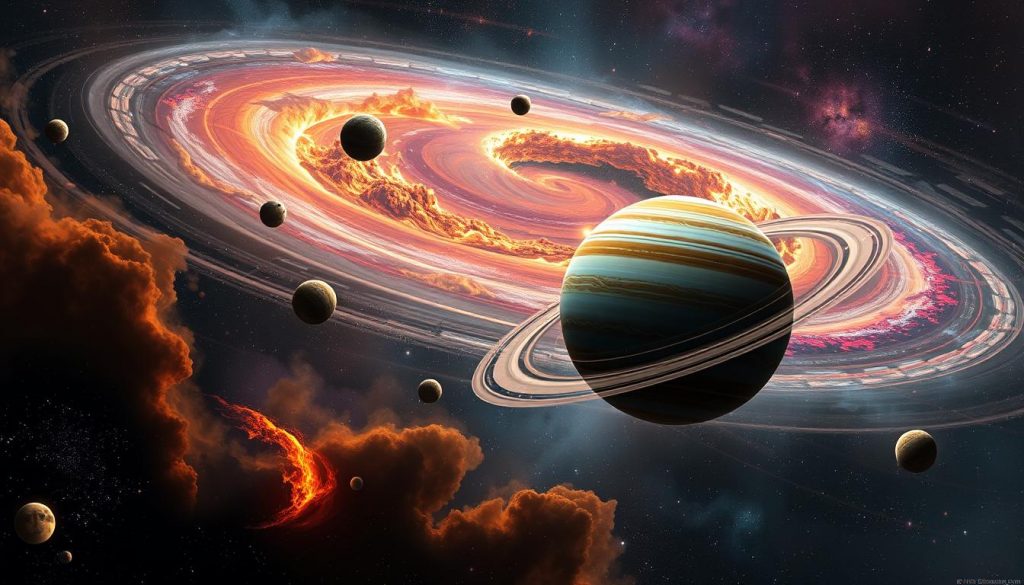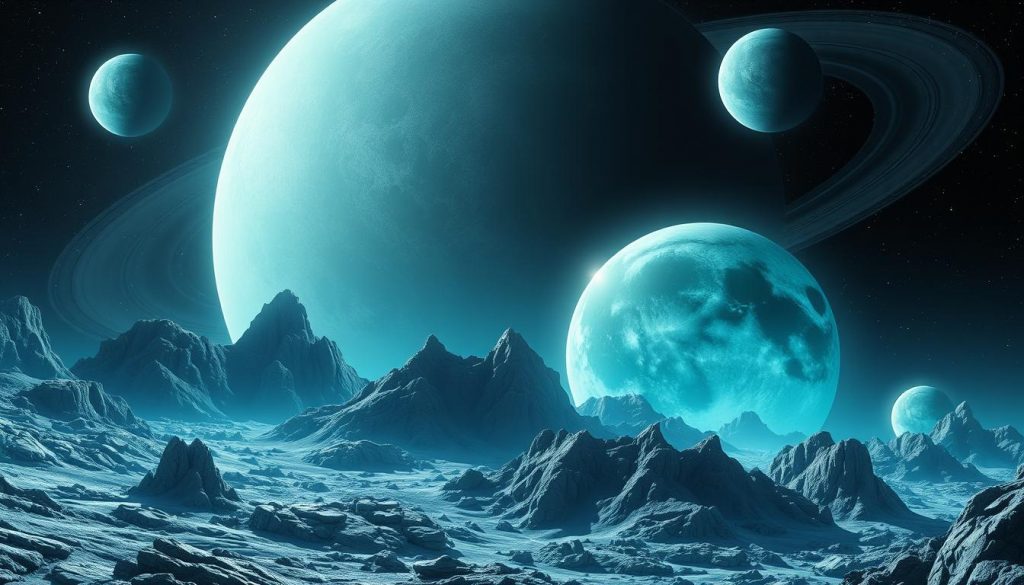Uranus’s mysterious tilt and its possible origins.
Uranus is a unique planet in our solar system. It has an axial tilt of about 98 degrees. This makes it the planet with the most extreme tilt known. Its tilt causes it to spin on its side, sparking interesting questions about its origins.
Anúncios
First spotted by Sir William Herschel in 1781, Voyager 2 accurately measured it in 1986. This tilt is key to Uranus’s internal workings and magnetic field. The mysteries of Uranus’s tilt help us understand how planets form in our solar system and beyond. Future missions aim to explore Uranus and solve these enigmas.
Key Takeaways
- Uranus has the highest axial tilt in the solar system at approximately 98 degrees.
- Understanding Uranus’s tilt can provide insight into planetary formation theories.
- This extreme tilt may result from early collisions with massive objects.
- Future missions to Uranus are set to launch, enhancing our knowledge of this peculiar ice giant.
- The axial tilt of Uranus significantly impacts its internal dynamics and magnetic field.
The Enigma of Uranus’s Tilt
The Uranus tilt is a mystery among the stars. It has an extreme tilt of about 98 degrees. This is unlike most planets, which usually tilt much less.
This tilt leads to extreme seasons on Uranus. The poles see very long days and nights. This creates interesting weather patterns and fast winds.
Scientists used to think a big impact caused Uranus’s tilt. But new research suggests it might have been an ancient satellite. This changes how we think about Uranus’s history and its place in the solar system.
Studying Uranus’s tilt helps us understand how planets form. It also tells us about exoplanets with similar tilts. This is important for learning about life beyond Earth. For more on this, check out this research.
| Characteristic | Uranus | Other Planets |
|---|---|---|
| Axial Tilt | 98 degrees | Less than 30 degrees (e.g., Earth) |
| Core Size | Similar to Earth | Varies by planet |
| Wind Speed | Hundreds of meters/second | Variable |
| Moon Count | More than 25 | Varies by planet |
| Composition | Ices (methane, ammonia, water) | Gas Giants differ significantly |
What Makes Uranus Unique Among Planets
Uranus is fascinating when we look at its features compared to Neptune. It’s the seventh planet from the Sun and the third largest. Its unique traits make it stand out, especially in planet comparisons.
Comparative Planetology: Uranus vs. Neptune
Uranus and Neptune are both ice giants but are quite different. Uranus tilts almost 90 degrees, making it look like it’s rolling. Neptune’s tilt is much less.
Both planets are very cold, but their weather is not the same. Uranus has storms bigger than the US. This is a unique feature.
Characteristics of Uranus’s Rotation
Uranus’s rotation is also special. A day on Uranus is just 17 hours and 14 minutes. This is much faster than its 84 Earth-year orbit.
Because of its tilt, Uranus’s poles get 21 years of constant sunlight or darkness. This creates a unique seasonal cycle. The winds on Uranus can reach up to 560 miles per hour, making it the windiest planet.
Historical Context of Uranus’s Formation
To grasp how Uranus formed, we must look back to the early solar system’s chaotic days. About 4 billion years ago, the universe was a place of constant collisions and changes. These events shaped Uranus and other giant planets.
The Solar System’s Chaotic Early Days
The solar system’s history is filled with violent events. Scientists have run over 50 simulations to understand Uranus’s birth. They found that a massive impactor, twice Earth’s size, hit Uranus hard.
This impact tilted Uranus’s axis almost straight up. Such a dramatic change would have deeply affected its atmosphere and density.
Planetary Formation Theories
Many theories try to explain Uranus’s unique traits. One theory says the big impact changed its tilt and how it kept its atmosphere. Researchers think Uranus mostly kept its atmosphere, suggesting a glancing blow rather than a direct hit.
This idea fits with the idea that gravity and available materials were key in the early days of planet formation.

| Formation Event | Description | Impact on Uranus |
|---|---|---|
| Time of Formation | Approximately 4 billion years ago | Sets the stage for Uranus’s current characteristics |
| Collisions | Numerous planetesimal collisions | Caused significant atmospheric and axial changes |
| Impactor Size | Twice the size of Earth | Resulted in a drastic axial tilt |
| Atmospheric Condition | Retained majority of atmosphere | Indicates a grazing blow scenario |
| Uranus’s Axial Tilt | Approximately 90 degrees | Sets it apart from other solar system planets |
Possible Causes of Uranus’s Tilt
Scientists are still trying to figure out why Uranus tilts so much. One big idea is the impact theory. It says a huge crash with another object made Uranus tilt so far.
This theory helps us understand what happened in such a big event.
The Impact Theory
The impact theory says Uranus was hit by something huge when it was young. This object was bigger than any asteroid or comet today. The hit was so strong it turned Uranus on its side.
Now, Uranus tilts about 97.77 degrees. This idea is important because it might happen to other planets too.
Evidence Supporting Collision Events
Studies and simulations show strong collision evidence for the impact theory. They show how a big hit could change a planet’s tilt. But, there’s a twist.
Neptune, which might have faced similar hits, stays upright. This makes us wonder about the exact conditions of these events.
| Planet | Axial Tilt (Degrees) | Known Moons | Notable Features |
|---|---|---|---|
| Uranus | 97.77 | 28 | Extreme seasonal changes |
| Neptune | 28.32 | 14 | Strongest winds in the solar system |
Uranus’s Tilt and Its Internal Dynamics
The tilt of Uranus is a whopping 98 degrees. This shows its complex internal workings are still a mystery to scientists. Underneath its thick atmosphere, Uranus has a mix of water, ammonia, and methane. This mix is key to the planet’s function.
Studying Uranus’s tilt helps us understand its gravity field. The core’s elements interact, affecting the atmosphere and energy flow. The planet’s winds can reach up to 900 km/h, influenced by its tilt and extreme seasons.
Research suggests Uranus might have oceans deep inside. These oceans could change the planet’s temperature and wind patterns. This shows Uranus is not just a static body but a dynamic world.
Scientists keep learning about Uranus’s inner workings. They find new things that change how we see these planets. By studying Uranus, we gain insights into its gravity and heat, and how it interacts with space.
Uranus’s Tilt: The Role of Ancient Moons
The tilt of Uranus is quite interesting. It makes us think about the role of its ancient moons. These lost satellites might have changed how the planet tilts. Simulations help us understand how these moons affected Uranus’s tilt.
Gravitational Influence of Lost Satellites
The ancient moons of Uranus were likely very massive. They pulled on the planet, causing it to tilt over time. When these moons disappeared, Uranus’s tilt became what we see today. Studying this helps us learn about Uranus’s past.
Recent Research Findings on Satellite Dynamics
New studies have given us insights into Uranus’s moons. They show that as moons moved closer, they could have changed the planet’s tilt. By studying today’s moons, scientists can see how the past moons affected Uranus. This helps us understand Uranus’s unique tilt better.

Complexities of Uranus’s Magnetic Field
Uranus’s magnetic field is a puzzle for scientists. It’s tilted 60 degrees from the planet’s rotation axis. This tilt leads to magnetic complexities, changing the field’s strength and pattern.
The Voyager 2 mission in 1986 gave us new insights. It found Uranus’s radiation belts are much weaker than expected. Voyager 2’s journey through a weak magnetic zone was especially enlightening.
Uranus’s magnetic field is different from Earth’s. Earth has strong radiation belts, while Uranus’s are weak. This difference affects how charged particles move around the planet.
Studying Uranus’s magnetic field helps us understand its auroras. The planet’s atmosphere is complex, with layers of water and hydrocarbons. This structure influences the magnetic field’s behavior.
The magnetic field of Uranus varies a lot. It can be very weak or moderate. These changes highlight the magnetic complexities of this icy planet. Scientists are still learning about how the magnetic field affects the atmosphere.
| Characteristic | Uranus | Neptune |
|---|---|---|
| Magnetic Tilt | 60 degrees | 47 degrees |
| Radiation Belt Strength | 100 times weaker than expected | Data not specified |
| Atmospheric Thickness | 3,000 miles | Thinner atmosphere |
| Core Size | Similar to Mercury | Similar to Mars |
Future Missions to Uranus: Unlocking Mysteries of the Tilt
Future missions aim to explore Uranus and solve its mysteries, especially its tilt. The Uranus Orbiter and Probe (UOP) will spend about 4.5 Earth years studying the planet. It will collect data on the atmosphere, interior, and magnetosphere, helping us understand its tilt.
These missions promise to deepen our knowledge of Uranus. Voyager 2’s flyby showed Uranus’s magnetosphere is unique, happening only 4% of the time. This rare event could affect the solar system, changing plasma levels in the magnetosphere. Long-term observations are key to understanding Uranus, not just flybys.
The UOP mission is seen as cost-effective compared to others, like Europa. This could help us learn more about Uranus’s moons, like Titania and Oberon. These moons might have subsurface oceans due to their interaction with Uranus’s magnetosphere.
New missions to Uranus are planned for the early 2030s, with more chances later. The next time we’ll see Uranus’s equinox is in 2049. This will light up unseen parts of its 27 known moons, giving us vital data for science.
| Mission Features | Uranus Orbiter and Probe (UOP) |
|---|---|
| Duration | 4.5 Earth years |
| Launch Window | Early 2030s |
| Cost | Low cost, cost-effective compared to Europa missions |
| Scientific Goals | Atmospheric and interior data collection |
| Historical Context | Follow-up to Voyager 2’s findings |
| Long-term Observation | Significant for understanding magnetic environments |
In summary, future missions will give us new insights into Uranus, its tilt, and its magnetic field. These explorations could reveal secrets of this distant planet in ways we never thought possible.
Conclusion
This article explored Uranus’s tilt and its many influences. A huge impact, possibly from a celestial object as big as Earth, is thought to have shaped Uranus. This event led to its unique atmosphere and magnetic field.
Uranus’s tilt also makes us rethink how planets form. Its 27 known moons add to its complex nature. This shows how much we still have to learn.
Studying Uranus is key to understanding other planets. Its distance from the Sun makes missions tough. But, this challenge makes the discoveries even more exciting.
Exploring Uranus can reveal secrets about our solar system’s past. Every new discovery helps us understand how planets evolve. This knowledge is crucial for studying other planets.
Future missions will build on what we’ve learned so far. They will help us uncover more about Uranus and its mysteries.
